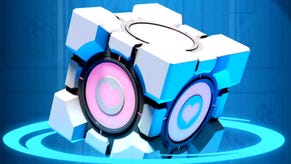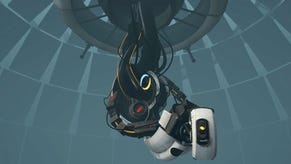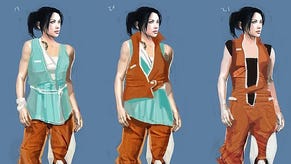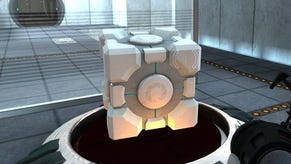Portal 2
Turrets syndrome.
Pneumatic Diversity Vents are up next - huge vacuum tubes that suck up everything you put beneath them, before spitting them out again somewhere nearby. Turn one on above a turret, and it will be whisked out of the way, but the real fun starts when you discover that you can take their suction power wherever you need it by simply placing an entry portal beneath them, which will then tug anything nearby through the next exit portal you fire out, regardless of where you stick it.
It's wonderful to watch, too: tiles are ripped off walls and shredded, tiny robotic voices sweetly mumble about "critical failures" before expiring, and you can only really marvel at the extra-terrestrial logic that dreams all this stuff up.
Next up are two different kinds of gels, both of which allow you to change the status of a surface, which is a lot more fun than it sounds. Repulsion Gel creates bright blue puddles of bounciness, which is good enough on its own but becomes genuinely astonishing the first time you accidentally bounce little blobs of it through portals, or spray it on two opposite walls and then ricochet between them like a pinball.
Propulsion Gel, meanwhile, is orange, which means I like it already, and lets you slide across it at crazy speeds, allowing you to build up the momentum necessary, for example, to project yourself far across a series of spikes that would otherwise cause you to expire.
Finally, there's the Thermal Discouragement Room, which houses bright red laser beams that burn through anything they touch. It's nothing but a hazard until you start folding the beam at right angles by placing mirrored cubes in its path, and then it becomes a murderous little path you can twist through mazes to kill the turret on the other side, or a kind of extension lead for getting light beams to switches that lurk just out of reach.
Almost all of the new mechanics fit quietly into Portal's gentle system of colour-coding, making for a game that's both stylish and easily readable, and they're all fun by themselves but far, far better when you start to combine them. They're enough to suggest a sequel that's every bit as devilish and dizzying as the first game, and that's before you throw in the thought of a bespoke set of two-player co-op levels which will run parallel to the main campaign.
Portal 2 promises to take you back, then: back to that creepy world of human lab rats, polite gun turrets, and lovably psychopathic super computers. But it also promises to take you forward, to a physics playground that manages to be much more intricate than anything you've experienced before, without ever bogging itself down in obtuse fiddliness.
That's the thing that makes you realise just how smart Valve really is. Not only has the developer managed to make Euclid-busting geometrical challenges seem breezy and moreish, it realises that the best puzzle games are the ones that are balanced so sweetly in terms of mechanics and difficulty that, ultimately, they make their players feel smart too.
Portal 2 is due out for PC, PS3 and Xbox 360 in 2011.










.png?width=291&height=164&fit=crop&quality=80&format=jpg&auto=webp)




.jpg?width=291&height=164&fit=crop&quality=80&format=jpg&auto=webp)
